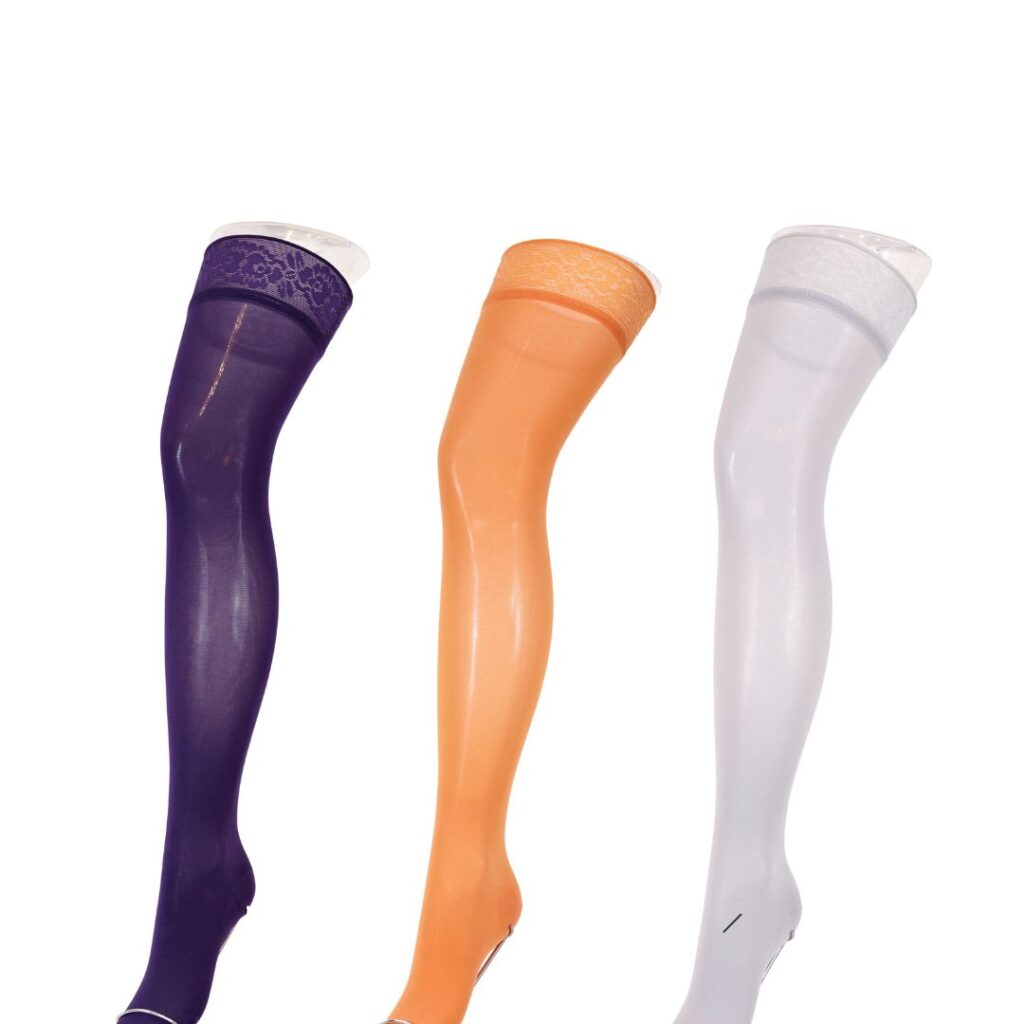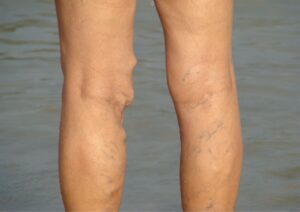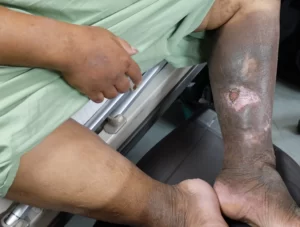Ankle and foot swelling, also known as peripheral oedema, can occur due to various reasons. It is commonly caused by fluid retention in the tissues, typically resulting from factors such as prolonged standing or sitting, pregnancy, excessive salt intake, certain medications, or underlying health conditions like heart, liver, or kidney disease.
Inadequate circulation, venous insufficiency, lymphatic issues, and injury or trauma can also contribute to swelling in the ankles and feet. It is important to consult a healthcare professional to determine the underlying cause and receive appropriate treatment for the swelling.
Why do ankles and feet swell?

Ankle swelling, also known as peripheral oedema, occurs when there is an abnormal accumulation of fluid in the tissues surrounding the ankle joint. The pathophysiology of ankle swelling can be influenced by various factors and underlying conditions:
1. Increased capillary filtration:
The primary mechanism behind ankle swelling is an increase in capillary filtration, which leads to fluid leaking out of the blood vessels into the surrounding tissues. This can occur due to factors such other symptoms such as increased capillary pressure, impaired venous or lymphatic drainage, or changes in capillary permeability.
2. Venous insufficiency:
When the veins in the legs and ankles are unable to effectively return blood back to the heart, blood pools in the lower extremities, causing increased hydrostatic, dangerously high blood pressure there, and fluid leakage into the tissues.
3. Lymphatic obstruction:
Lymphatic vessels play a crucial role in maintaining fluid balance in the body. When there is a blockage or dysfunction in the lymphatic system, lymphatic fluid cannot properly drain, leading to fluid buildup and swelling of lymph nodes.
4. Inflammation and tissue damage:
Ankle swelling can also result from inflammatory processes or tissue damage, such as sprains, fractures, or infections. Inflammation causes blood vessels to dilate and become more permeable, allowing fluid and inflammatory cells to accumulate in the tissues.
5. Systemic conditions:
Ankle swelling can be a manifestation of underlying systemic conditions, including heart failure, kidney disease, liver disease, or certain medications. These conditions can disrupt fluid balance in the body and contribute to fluid retention causing swelling, and ankle swelling.
It is important to note that the mechanism of ankle swelling can vary depending on the underlying cause and individual factors. Proper evaluation and diagnosis by a healthcare professional are necessary to determine the specific mechanisms contributing to ankle swelling and guide appropriate treatment.
What are the Most Common Causes of Swollen Ankles?
Swollen ankles can be caused by various factors, including:
1. Fluid retention:
Excess fluid can accumulate in the ankles and feet due to conditions like edema, a chronic kidney disease or, heart failure, or liver disease.
2. Injury or trauma:
Sprains, strains, fractures, or other injuries to the ankles can lead chest pain or to swelling.
3. Inflammation:
Conditions such as arthritis, tendonitis, or bursitis can cause inflammation and swelling in the foot and ankle joints.
4. Venous insufficiency:
When the veins in the legs have difficulty returning blood to the heart, it can result in fluid accumulation in leg veins and swelling in the ankles.
5. Infection:
Infections in the ankles or lower legs, such as cellulitis, can cause localized swelling.
6. Medications:
Certain medications, such as calcium channel blockers, steroids, or nonsteroidal anti-inflammatory drugs (NSAIDs), may cause fluid retention and ankle swelling as a side effect.
7. Pregnancy:
Hormonal changes during pregnancy can lead to fluid retention and swelling in the ankles and feet.
It is important to consult a healthcare professional if you experience persistent or severe ankle swelling, as it may be indicative of an underlying medical condition that requires evaluation and treatment.

When should you worry about ankle swelling?
While ankle swelling can often be a harmless and temporary condition, there are certain situations where you should seek urgent medical attention for ankle swelling:
1. Sudden and severe swelling:
If your ankle swells rapidly and significantly without an obvious cause, it could be a sign of a serious condition such as deep vein thrombosis (DVT) or a fracture.
2. Pain and redness:
If your swollen foot or ankle is accompanied by severe pain, redness, warmth, or tenderness, it may indicate an infection or an inflammatory condition that requires medical evaluation.
3. Difficulty walking or bearing weight:
If your swollen ankle impairs your ability to walk or put weight on the affected lower leg part, it could be a sign of a more significant injury or structural problem, such as a ligament tear or joint damage.
4. Persistent swelling:
If your ankle remains swollen for an extended period, despite self-care measures, rest, and elevation, it’s advisable to consult a healthcare professional for further evaluation.
5. History of medical conditions:
If you have a history of heart, liver, or kidney disease, or if you’re on medications that can cause swelling, it’s important to monitor your foot and ankle swelling more closely and consult your healthcare provider if there are any concerns.
In any of these situations, it’s best to err on the side of caution and seek medical advice to determine the underlying cause and appropriate treatment for your ankle swelling.
How Can You Reduce The Swelling in Your Ankles?

To reduce swelling in your ankles, you can try the following self-care measures:
1. Elevate your legs:
Prop up your legs on a cushion or pillow to raise them above heart level. This helps to promote fluid drainage and reduce swelling.
2. Apply cold compress:
Place a cold pack or ice wrapped in a cloth on the swollen area for 15-20 minutes at a time, several times a day. Cold therapy can help constrict blood vessels and reduce swelling.
3. Compression stockings:
Wear compression stockings or compression socks, that provide gentle pressure on your legs and ankles. These garments help to improve circulation and prevent fluid buildup.
4. Stay active:
Engage in regular physical activity to promote blood flow and prevent fluid from pooling blood clots in your ankles. Simple exercises like walking or ankle pumps can be beneficial.
5. Avoid prolonged sitting or standing:
Take breaks if you have to sit or stand for long periods. Move around or perform ankle exercises to keep the blood flowing.
6. Watch your salt intake:
Limit your consumption of salty foods, as excess sodium can contribute to fluid retention and swelling.
What are The Medical Options for Swollen Ankles?
Medical treatments for a swollen feet and ankles may vary depending on the underlying cause of mild swelling. Some common treatment options include:
1. Diuretics: These medications help to reduce fluid retention by increasing urine output, which can alleviate swelling in the feet and ankles.
2. Compression therapy: Compression stockings or bandages can help improve circulation and reduce swelling by applying pressure to the affected area.
3. Medications for underlying conditions: If the swelling is due to an underlying medical condition such as heart failure or kidney disease, treating and managing the primary, underlying health condition can help reduce ankle swelling.
4. Elevation: Elevating the legs and ankles above heart level can promote the drainage of fluid and reduce leg swelling too.
5. Physical therapy: In cases where ankle swelling is due to an injury or musculoskeletal condition, physical therapy exercises and techniques may be recommended to improve mobility, strengthen muscles, and reduce swelling.
What are The Surgical Options?
Surgical treatments for swollen ankles are typically reserved for cases where conservative measures have failed or when there is an underlying structural issue causing the swelling. Some surgical options for swollen ankles include:

1. Arthroscopy: This minimally invasive procedure involves inserting a small camera into the ankle joint to assess and treat any internal damage or inflammation contributing to the swelling if the swelling is due to a knee joint issue.
2. Ligament repair or reconstruction: If ankle instability or ligament damage is causing the swelling, surgical repair or reconstruction may be performed to restore stability and reduce swelling.
3. for chronic Venous insufficiency or lymphatic surgery: In cases where ankle swelling is due to venous insufficiency, interventions such as sclerotherapy, endovenous laser ablation, or radiofrequency ablation can be considered to reduce the swelling.
4. Lymphatic surgery: in case of lymphatic obstruction, lymphatic vessel bypass can be considered to improve fluid drainage and reduce swelling.
4. Tendon repair: If tendon damage or rupture is causing the swelling, surgical repair or reconstruction may be performed to restore proper function and alleviate excessive swelling.
5. Joint replacement: In severe cases of ankle arthritis or joint degeneration causing persistent swelling and pain, ankle joint replacement surgery may be recommended to relieve symptoms and improve mobility.
It is important to consult with a healthcare professional to discuss the specific surgical options available based on the underlying cause of the swollen ankle and the individual’s overall health and condition.
Conclusion
In conclusion, swollen ankles can be caused by a variety of factors, ranging from benign and temporary conditions to more serious underlying medical issues.
Common causes include prolonged standing or sitting, excessive salt intake, pregnancy, obesity, and certain medications. However, it is crucial to consider potential underlying health conditions such as venous insufficiency, lymphatic obstruction, heart failure, kidney disease, or liver disease, as they can also contribute to ankle swelling.
Prompt medical evaluation is recommended for persistent or concerning ankle swelling, as it can help identify the root cause and guide appropriate treatment. Lifestyle modifications, such as elevation, exercise, compression stockings, and dietary changes, may be beneficial in managing mild cases.
In more severe cases or when an underlying condition is present, medical or surgical interventions may be necessary.
Overall, understanding the potential causes of swollen legs and ankles empowers individuals to seek appropriate medical attention and take proactive steps to promote leg health and overall well-being.










